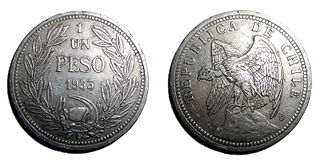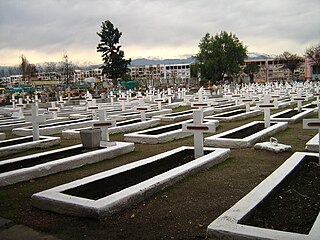
Minera Escondida is a mining company that operates two open pit copper mines in the Atacama Desert, 170 km southeast of Antofagasta in northern Chile. It is currently the highest producing copper mine in the world. Its 2007 production of 1.483 million tons of the metal was worth US$10.12 billion, mainly as metal in concentrate, but some as cathode, and was 9.5% of world output and 26% of Chilean production, according to the US Geological Survey's preliminary estimates of 2007 world mine output.

Chuquicamata is the largest open pit copper mine in terms of excavated volume in the world. It is located in the north of Chile, just outside Calama, at 2,850 m (9,350 ft) above sea level. It is 215 km (134 mi) northeast of Antofagasta and 1,240 km (770 mi) north of the capital, Santiago. Flotation and smelting facilities were installed in 1952, and expansion of the refining facilities in 1968 made 500,000 tons annual copper production possible in the late 1970s. Previously part of Anaconda Copper, the mine is now owned and operated by Codelco, a Chilean state enterprise, since the Chilean nationalization of copper in the late 1960s and early 1970s. Its depth of 850 metres (2,790 ft) makes it the second deepest open-pit mine in the world, after Bingham Canyon Mine in Utah, United States.

Codelco is a Chilean state-owned copper mining company. It was formed in 1976 from foreign-owned copper companies that were nationalised in 1971.

The nationalization of the Chilean copper industry, commonly described as the Chileanization of copper was the process by which the Chilean government acquired control of the major foreign-owned section of the Chilean copper mining industry. It involved the three huge mines known as 'La Gran Mineria' and three smaller operations. The Chilean-owned smaller copper mines were not affected. The process started under the government of President Carlos Ibáñez del Campo, and culminated during the government of President Salvador Allende, who completed the nationalization. This "act of sovereignty" was the espoused basis for a later international economic boycott, which further isolated Chile from the world economy, worsening the state of political polarization that led to the 1973 Chilean coup d'état.

Kennecott Utah Copper LLC (KUC), a division of Rio Tinto Group, is a mining, smelting, and refining company. Its corporate headquarters are located in South Jordan, Utah. Kennecott operates the Bingham Canyon Mine, one of the largest open-pit copper mines in the world in Bingham Canyon, Salt Lake County, Utah. The company was first formed in 1898 as the Boston Consolidated Mining Company. The current corporation was formed in 1989. The mine and associated smelter produce 1% of the world's copper.

The Bingham Canyon Mine, more commonly known as Kennecott Copper Mine among locals, is an open-pit mining operation extracting a large porphyry copper deposit southwest of Salt Lake City, Utah, in the Oquirrh Mountains. The mine is the largest man-made excavation, and deepest open-pit mine in the world, which is considered to have produced more copper than any other mine in history – more than 19,000,000 short tons. The mine is owned by Rio Tinto Group, a British-Australian multinational corporation. The copper operations at Bingham Canyon Mine are managed through Kennecott Utah Copper Corporation which operates the mine, a concentrator plant, a smelter, and a refinery. The mine has been in production since 1906, and has resulted in the creation of a pit over 0.75 miles (1,210 m) deep, 2.5 miles (4 km) wide, and covering 1,900 acres. It was designated a National Historic Landmark in 1966 under the name Bingham Canyon Open Pit Copper Mine. The mine experienced a massive landslide in April 2013 and a smaller slide in September 2013.
The Anaconda Copper Mining Company, known as the Amalgamated Copper Company from 1899 to 1915, was an American mining company headquartered in Butte, Montana. It was one of the largest trusts of the early 20th century and one of the largest mining companies in the world for much of the 20th century.

Sewell is an uninhabited Chilean mining town located on the slopes of the Andes in the commune of Machalí in Cachapoal Province, Libertador General Bernardo O'Higgins Region, at an altitude of between 2,000 and 2,250 metres. In 2006, it was designated as a UNESCO World Heritage Site. It is known as a former company town, developed by Braden Copper Company for housing the workers associated with the operations of El Teniente, the largest underground copper mine in the world.
The 1983 Arizona copper mine strike began as a labour dispute between the Phelps Dodge Corporation and a group of union copper miners and mill workers, led by the United Steelworkers. The subsequent strike lasted nearly three years and resulted in the replacement of most of the striking workers and decertification of the unions. It is regarded as an important event in the history of the United States labor movement.

In the United States, copper mining has been a major industry since the rise of the northern Michigan copper district in the 1840s. In 2017, the US produced 1.27 million metric tonnes of copper, worth $8 billion, making it the world's fourth largest copper producer, after Chile, China, and Peru. Copper was produced from 23 mines in the US. Top copper producing states in 2014 were Arizona, Utah, New Mexico, Nevada, and Montana. Minor production also came from Idaho, and Missouri. As of 2014, the US had 45 million tonnes of known remaining reserves of copper, the fifth largest known copper reserves in the world, after Chile, Australia, Peru, and Mexico.

El Salvador is a mining town in the commune of Diego de Almagro, Chañaral Province, Atacama Region, Chile. Located at an elevation of more than 2,400 meters in the foothills of the Andes and in the middle of the Atacama Desert, it has a population of approximately 7,000 inhabitants. At its peak, El Salvador once had a population of 34,000 inhabitants.

Braden Copper Company was an American company that controlled the El Teniente copper mine in Chile until 1967 when its copper holdings were nationalized.

El Teniente is an underground copper mine located in the Chilean Andes, 2,300 m (7,500 ft) above mean sea level. It is in the commune of Machalí in Cachapoal Province, Libertador General Bernardo O'Higgins Region, near the company town of Sewell. This was established for the workers and their families.
The mining sector in Chile is one of the pillars of Chilean economy and copper exports alone stands for more than one third of government income. Most mining in Chile is concentrated to the Norte Grande region spanning most of the Atacama Desert. Mining products of Chile includes copper, gold, silver, molybdenum, iron and coal. Chile was, in 2019, the world's largest producer of copper, iodine and rhenium, the second largest producer of lithium and molybdenum, the sixth largest producer of silver, the seventh largest producer of salt, the eighth largest producer of potash, the thirteenth producer of sulfur and the thirteenth producer of iron ore in the world. In the production of gold, between 2006 and 2017, the country produced annual quantities ranging from 35.9 tons in 2017 to 51.3 tons in 2013.

The 1945 El Teniente mining accident, known locally as the Smoke Tragedy, is the largest mining accident in metal extraction in the history of Chile and, as of 2005, worldwide. It happened on June 19, 1945, in Chile's El Teniente mine in the Andes, which belonged to Braden Copper Company, a subsidiary of Kennecott Copper Corporation, both of the United States. A total of 355 men died, largely because of a nearby fire whose smoke trapped the workers in tunnels and resulted in carbon monoxide poisoning. Another 747 men were injured by the smoke.

Escondida is a copper mine at 3,100 metres (10,200 ft) elevation in the Atacama Desert in Antofagasta Region, Chile.

Los Pelambres mine is a copper mine located in the north-central of Chile in Coquimbo Region. It is one of the largest copper reserves in the world, having estimated reserves of 4.9 billion tonnes of ore grading 0.65% copper.

Ferronor is a Chilean railway company operating on the old Red Norte of Empresa de los Ferrocarriles del Estado, which was privatised in 1997. Since 2004 the primary shareholder is APCO.

Potrerillos is a ghost town in the interior of Atacama Region, Chile. Potrerillos became established as mining camp in the 1920s by Andes Copper Mining Company.
Charles M. Brinckerhoff was an American engineer and businessman who was formerly the chairman and CEO of Anaconda Copper, the world's largest producer of copper. He was a recipient of the Hoover Medal and the William Lawrence Saunders Gold Medal.

















